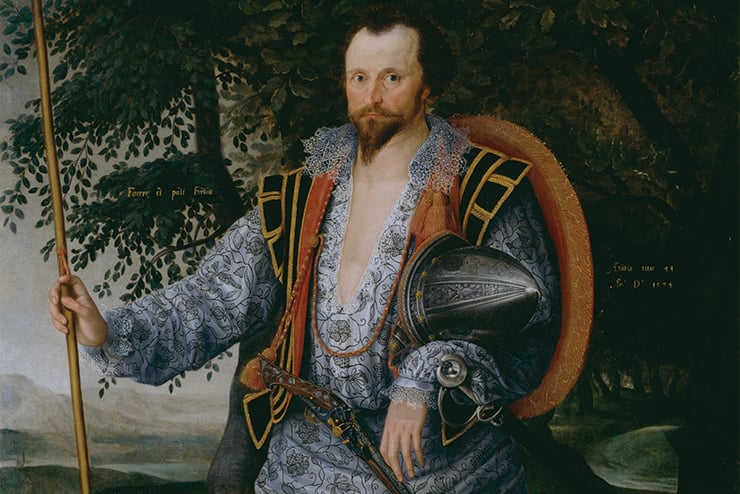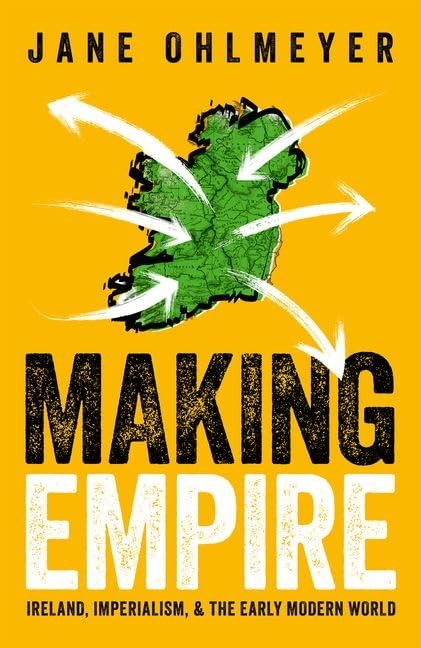Making Empire: Ireland, Imperialism and the Early Modern World
by Jane Ohlmeyer
Oxford University Press
368 pp., $36.00
Thirty Anglo-Norman knights landed at Bannow Strand in County Wexford in southeastern Ireland on May 1, 1169, to help the usurped Diarmait Mac Murchada reclaim the throne of Leinster. There had always been interactions among the isles, but those knights landing on “Bannow’s Lonely Shore” (the title of a famous folk song) were the start of the British Empire and, according to radical imaginations, 800 years of oppression. As Engels told Marx in 1856, “Ireland may be regarded as the first English colony.”
Norman and then English rulers often found it hard to administer their writ beyond the eastern strip around Dublin called “The Pale” and Irish coastal towns. Many arrivals assimilated into Irish culture rather than the other way around, leading to a complaint that they were “more Irish than the Irish.” Then in 1542, Henry VIII assumed the title “King of Ireland.” English soldiers started coming in large numbers, driven by a blend of ambition, cupidity, Protestant evangelism, and the strategic aim of denying use of the territory to France or Spain. Men-on-the-make, including Edmund Spenser and Walter Raleigh, were granted extensive estates at the expense of those already there. They strove to impose English law and Reformed religion, often with extreme brutality. The Faerie Queene’s author also wrote the pamphlet “A View of the Present State of Ireland,” which called for ethnic cleansing and extirpation of the native culture. Raleigh admired his half-brother Humphrey Gilbert, who adorned his headquarters with rows of “rebel” heads on spikes.
Along with their language, law, and religion, the English also imposed new mercantile and urbanizing models on a country accustomed to pastoralism and exchange; Jonathan Swift would later complain of how English legislators “with the spirit of shopkeepers framed laws for the administration of kingdoms.” There were onerous and humiliating restrictions on the native Irish in English-held towns, as expressed in a 1581 ordinance which declared, “Neither O nor Mac shall strut nor swagger through the streets of Galway.”
Before 1169, Irish people had frequently lived short and unhealthy lives; now indignity was added to their troubles. The process is remembered as the “Plantations”—a word still so full of poisonous resonance that it is now being applied to the cities where the arrival of hundreds of thousands of “asylum-seekers” is literally changing the face of Ireland.
Jane Ohlmeyer, a historian from Trinity College Dublin—which was chartered by Queen Elizabeth I in 1592 to educate “our people there” and ensure they were not “infected with poperie”—starts her account around 1594, during the Nine Years’ War. Many Gaelic lords had pragmatically come to terms with the invaders under the policy called “surrender and regrant,” whereby they were allowed to keep their estates if they promised to “civilize” them and be loyal to the Crown. Others led by the Earl of Tyrone made a last stand but were defeated militarily in 1603 and symbolically in 1607, when the supposedly temporary “Flight of the Earls” to the continent became permanent. It was a long and vicious campaign that gave England’s generals grief and elicited powerful anti-Irish feeling among the English population.
This feeling is reflected in Shakespeare, who mentions Ireland 31 times in his plays. Captain MacMorrice, an Irish soldier in Henry V, wonders famously, “Of my nation? What ish my nation?” Tellingly, MacMorrice disappears from the text before the play’s climax at Agincourt, while the English and Welsh stand firm. Meanwhile, real-life Irishmen were sailing with Drake, and despite their Catholicism were happy to help him “singe the King of Spain’s beard.”
Instrumental in the Earls’ eventual defeat were the descendants of Anglo-Norman invaders, called the “Old English”—although this demonstration of their loyalty never cleared them of imputations of “half-Irish” unreliability. During the 1640s, as Ireland descended into Catholic rebellion and then wider Civil Wars, the Old English suffered as greatly at the hands of Cromwell’s “New English” for their loyalty to the king as the Catholic Irish suffered for their faith. Between 1641 and 1670, Catholic land ownership halved, and thousands were “barbadosed”—shipped to the Caribbean as indentured servants, where they were derided even by the slaves.
The English could be pragmatic, however, and were prepared to overlook an Irish wife’s regrettable Catholicism if she came with land, while embattled Irishwomen were often prepared to marry even Protestant protectors. Their children often went to England to be educated but, however “Englished” they became, never quite escaped what George Bernard Shaw later called John Bull’s Other Island.
Tangled allegiances are symptomatic of Ireland’s story. This was symbolized in an extraordinary 1594 painting of the English Captain Thomas Lee, showing him bare-legged and carrying a spear (ergo “Irish”) but wearing a very “English” and wonderfully sumptuous Tudor tunic. Some Anglo-Irishmen always called themselves English, however long their families had been in Ireland, even if they were Catholics. As the Dublin-born Duke of Wellington is reported to have snorted when he was referred to as an Irishman, “Being born in a stable does not make a man a horse!”
But other Anglo-Irish Protestants would identify strongly with Irish causes—in some cases over-identify, out of apparent anxiety to belong. Even now, the etiolated Anglo-Irish are semi-detached from both countries, frequently seen as Irish in England and as English in Ireland. As a Dublin Anglican myself, I was occasionally dubbed a “West Brit” or a “bush baptist.” As Louis MacNeice concludes gnomically in his book on W. B. Yeats, “It is easy to be Irish; it is difficult to be Irish.”
For every Irishman or woman who resented English overlordship, there were others who resignedly accepted their fate or embraced imperial opportunities. Ohlmeyer demonstrates convincingly that the British Empire could not have come into being if Ireland had not set a historical precedent, and that Irish individuals and Irish resources were instrumental in British imperial expansion. Lessons learned in Ireland were applied worldwide, in almost every sphere of activity or thought. This is a necessary antidote to Irish nationalist myths about principled and universal anti-imperial resistance. “Many in Ireland have … conveniently forgotten our imperial past or are simply oblivious to it,” Ohlmeyer notes. “Ignorance of Ireland’s engagement with empire has enabled extreme nationalists to manipulate the past.”
There is plentiful postcolonial revisionism that strives to reconcile Irish history with modern multiculturalism. Ohlmeyer is well acquainted with such “discussions about how to diversify Irish history.” The leaden cliché “lived experience” makes multiple unwelcome appearances in her book, and she waxes sentimental about a knife-wielding Nigerian (whose name she misspells) fatally shot by police in 2021.
But Ohlmeyer practices a more incisive “inclusiveness,” revealing substantive and often unexpected stories rather than retconning to placate presentist biases. Irish nationalists, for example, have often portrayed their “struggle” as analogous to other anti-colonial movements. In 2016, the grimly progressive president of Sinn Féin, Gerry Adams, was so inspired watching Quentin Tarantino’s 2012 Southern slavery film, Django Unchained, that he told Twitter he was “a Ballymurphy n***er”—a remark generally greeted with groans. Contrary to Adams’ imagination, Ohlmeyer shows early modern Irish captains trading slaves in Caribbean ports, with profits from chattel slavery flowing into the pockets of lionized Irishmen like Bishop Berkeley and Edmund Burke.
According to Sean Connolly’s 2022 On Every Tide, even Irish-Americans in the United States’ Union Army “were noted for their lack of sympathy with the abolitionist cause.” The celebrated 19th-century nationalist John Mitchel simultaneously agitated against English imperialism and defended the Confederacy.
In the 1680s, Samuel Pepys worried about the loyalty of the many Irish soldiers already garrisoning Tangiers. By the 1890s, the British forces in India were almost two-thirds Irish, and notorious for their bravery, brawling, and racism. In 1919, the two British officers responsible for the infamous Amritsar massacre of hundreds of Indian protestors were both Irish. After 1907, all aspirant colonial police officers trained with the Royal Irish Constabulary. Huge numbers of Irishmen—not to mention Britons of Irish descent—fought for Britain in the two world wars.
Despite everything, modern Ireland and England are connected by a thousand claims of culture, experience, genetics, and geography. It is salutary to remember these intimate understandings in the present era of imperialism—an imperialism not of expansion but of implosion. The swaggering warriors of Wexford have been superseded by slyer operators: liberals, whose symbol could be the migrant tent city recently occupying Dublin’s elegant streets. For decades now, this empire of abnegation has been striking back at England; it is finally turning its eyes on long-insulated but—we now know—equally implicated Ireland.


Leave a Reply